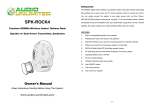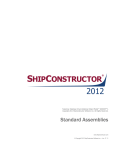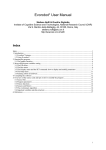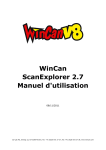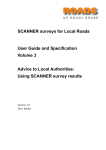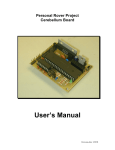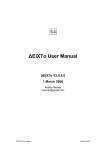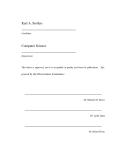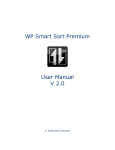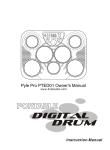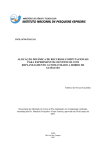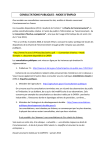Download EUROPA2: User and Contributor Guide
Transcript
EUROPA 2: User and Contributor Guide
Tania Bedrax-Weiss
Conor McGann
Andrew Bachmann
Will Edgington
Michael Iatauro
QSS Group Inc.
Computational Sciences Division
NASA Ames Research Center
Moffett Field, CA 94034-1000
{tania,cmcgann,bachmann,wedgingt,miatauro}@email.arc.nasa.gov
February 7, 2005
Contents
1 Work In Progress
2 Introduction
2.1 Plan Services . . . . . . .
2.2 EUROPA 2 Design Goals
2.2.1 Efficiency . . . . .
2.2.2 Flexibility . . . . .
2.2.3 Extensibility . . .
2
.
.
.
.
.
.
.
.
.
.
.
.
.
.
.
.
.
.
.
.
.
.
.
.
.
.
.
.
.
.
.
.
.
.
.
.
.
.
.
.
.
.
.
.
.
.
.
.
.
.
.
.
.
.
.
3 Concepts
3.1 Plans in Planning, Scheduling and Execution
3.2 Model-Based Planning . . . . . . . . . . . . .
3.3 Partial Plans: States and Relationships . . .
3.4 Token State Model . . . . . . . . . . . . . . .
3.5 Planning/Scheduling Decisions . . . . . . . .
3.6 Early vs. Delayed Commitment . . . . . . . .
.
.
.
.
.
.
.
.
.
.
.
.
.
.
.
.
.
.
.
.
.
.
.
.
.
.
.
.
.
.
.
.
.
.
.
.
.
.
.
.
.
.
.
.
.
.
.
.
.
.
.
.
.
.
.
3
3
4
4
5
5
.
.
.
.
.
.
.
.
.
.
.
.
.
.
.
.
.
.
.
.
.
.
.
.
.
.
.
.
.
.
.
.
.
.
.
.
.
.
.
.
.
.
.
.
.
.
.
.
.
.
.
.
.
.
.
.
.
.
.
.
.
.
.
.
.
.
5
5
6
6
7
7
8
4 Hello Rover - Getting started with PLASMA
4.1 Creating a Project . . . . . . . . . . . . . . . .
4.2 Building a simple model . . . . . . . . . . . . .
4.3 Creating an initial state . . . . . . . . . . . . .
4.4 Running the planner . . . . . . . . . . . . . . .
.
.
.
.
.
.
.
.
.
.
.
.
.
.
.
.
.
.
.
.
.
.
.
.
.
.
.
.
.
.
.
.
.
.
.
.
.
.
.
.
8
9
9
10
11
1
2
1 WORK IN PROGRESS
5 Developing Your Own Model In NDDL
5.1 Rover: The Robotic Geologist . . . . . . . . . . . . . . . . . .
5.2 Locations and Paths . . . . . . . . . . . . . . . . . . . . . . .
5.3 Instruments . . . . . . . . . . . . . . . . . . . . . . . . . . . .
5.4 Batteries . . . . . . . . . . . . . . . . . . . . . . . . . . . . . .
5.5 Rovers . . . . . . . . . . . . . . . . . . . . . . . . . . . . . . .
5.6 Basic Rules . . . . . . . . . . . . . . . . . . . . . . . . . . . .
5.7 Advanced Rules . . . . . . . . . . . . . . . . . . . . . . . . . .
5.8 Recap . . . . . . . . . . . . . . . . . . . . . . . . . . . . . . .
5.9 Formulate and solve a planning problem . . . . . . . . . . . .
5.10 Visualization of the plan and planning process in PlanWorks
5.11 Debugging . . . . . . . . . . . . . . . . . . . . . . . . . . . . .
.
.
.
.
.
.
.
.
.
.
.
.
.
.
.
.
.
.
.
.
.
.
6 PLASMA System Architecture
7 Customization and Extension
7.1 Configuration and Assembly . . . . .
7.2 Using and extending the CBPlanner
7.3 Custom constraints . . . . . . . . . .
7.4 Custom propagation . . . . . . . . .
7.5 Building model specializations . . . .
7.6 Custom rule implementations . . . .
7.7 Specialized domains . . . . . . . . .
7.8 External data integration . . . . . .
7.9 Listeners and Loggers . . . . . . . .
7.10 Integration to PlanWorks . . . . . .
13
13
14
15
16
17
18
21
23
24
25
32
36
.
.
.
.
.
.
.
.
.
.
.
.
.
.
.
.
.
.
.
.
.
.
.
.
.
.
.
.
.
.
.
.
.
.
.
.
.
.
.
.
.
.
.
.
.
.
.
.
.
.
.
.
.
.
.
.
.
.
.
.
.
.
.
.
.
.
.
.
.
.
.
.
.
.
.
.
.
.
.
.
.
.
.
.
.
.
.
.
.
.
.
.
.
.
.
.
.
.
.
.
.
.
.
.
.
.
.
.
.
.
.
.
.
.
.
.
.
.
.
.
.
.
.
.
.
.
.
.
.
.
.
.
.
.
.
.
.
.
.
.
.
.
.
.
.
.
.
.
.
.
.
.
.
.
.
.
.
.
.
.
38
38
41
41
42
42
42
42
42
42
42
8 Contributing to EUROPA 2
42
9 Appendices
9.1 Appendix
9.2 Appendix
9.3 Appendix
9.4 Appendix
9.5 Appendix
43
43
44
46
46
46
A: NDDL Language Reference . . .
B: Temporal Relations . . . . . . .
C: Constraint Library Reference . .
D: Test Language Specification and
E: Coding Guidelines . . . . . . . .
10 Acknowledgements
1
. . .
. . .
. . .
Use
. . .
.
.
.
.
.
.
.
.
.
.
.
.
.
.
.
.
.
.
.
.
.
.
.
.
.
.
.
.
.
.
.
.
.
.
.
.
.
.
.
.
48
Work In Progress
This manual is still work in progress. Here is a preliminary list of things that
we need to do:
1. Review organization: if reader doesn’t know anything about EUROPA
he/she may be lost in the “translation”.
3
2. Describe entities and relationships in the system (possibly include an entities diagram explaining the relationships).
3. Describe mapping from planning into constraints
4. Describe planning decisions and how they translate to changes in the plan
database
5. Describe extensions and external hooks
2
Introduction
EUROPA 2 is the next generation of the Extensible Universal Remote Operations Architecture. Like the CLARATy robotics control architecture [11],
MDS [3], or ILOG [10], EUROPA 2 is a component-based software library for
representation and reasoning with plans and schedules. Our goal in developing EUROPA 2 is to provide a fast, flexible, extensible, reusable technology
platform for building planning and scheduling applications suitable for space
exploration.
EUROPA [9, 5] which has been the core planning technology for a variety of NASA-relevant research and mission applications. A notable example is
MAPGEN [1, 2], the ground-based daily activity planning system for the Mars
Exploration Rover mission. EUROPA in turn is derived from HSTS which was
the planner for the Remote Agent [6]. EUROPA 2 builds on the legacies of
EUROPA and HSTS and provides improvements in performance, expressivity,
reasoning capabilities, flexibility, extensibility, and modularity which has opened
the technology to a broader range of planning techniques (e.g. POCL planning).
2.1
Plan Services
EUROPA 2 provides the following services:
• Domain modeling: for describing planning domains
• Plan representation: for updating partial plans
• Constraint propagation: for propagating the consequences of updates to
plans and determining violations
• Subgoaling: for generating consequences of commitments in the plan
• Flaw definition: for specifying flaws from a partial plan
• Decision management: for generating and resolving flaws
• Plan assessment: for determining plan completeness
4
2 INTRODUCTION
Each of these services can be used independently or in conjunction to build
applications by creating an assembly which composes the services needed. Please
see Section 7.1 for more information.
EUROPA 2 provides the New Domain Description Language NDDL, which
deviates substantially from DDL in that it provides an object oriented syntax.
It is also compiled, instead of interpreted. NDDL provides syntax for describing
objects, timelines, resources, predicates, rules, variables, and constraints. It also
provides facilities like inheritance and containment to describe complex objects.
Please see Section 5 for more information on NDDL.
Plan representation is a service provided by the Plan Database, much as it
was in EUROPA. The Plan Database responds to plan modification operations
by updating the partial plan or invoking specialized components to update parts
of the partial plan. Constraint propagation, for instance, is a service provided by
the Constraint Engine and is in charge of responding to updates to constraints
and variables triggered by the plan modification operations. The Rules Engine
is in charge of subgoaling also in response to plan modification operations.
Flaw definition, decision management, and plan assesment services are provided by the CBPlanner module. The CBPlanner module implements a chronological backtracking planner that resolves all flaws in the partial plan except for
temporal variable assignments as described in the literature [8, 4].
The philosophy underlying EUROPA 2 is to acknowledge up front that no
one size fits all when it comes to which techniques to use, and which capabilities
to employ. Consequently, EUROPA 2 is engineered to allow people to take just
what they need, discard what they do not, and integrate extensions to suit their
particular requirements in a straighforward manner. The design strategy is to
focus on a core framework defininig the principal abstractions and interactions
induced by our underlying paradigm. We then provide concrete components to
allow particular assemblies to be defined.
2.2
EUROPA 2 Design Goals
To meet the needs of missions and research projects, the design of EUROPA 2
must be: 1. Efficient to ensure low latency for operations and queries; 2. Flexibile to ensure services can be selected and flexibly integrated; 3. Extensible
to ensure services can be enhanced to meet the needs of research or mission
applications.
2.2.1
Efficiency
EUROPA 2 has produced significant gains in speed over EUROPA. The primary
contributors to the improvement arise from: 1. Fast interfaces and specialized
implementations: the ability to tune implementations using inheritance provides
speed improvements in key areas such as operations on domains. 2. Efficient
merging: EUROPA 2 provides an algorithm to handle merging operations that
disables redundant constraints arising in the plan database. 3. Incremental relaxation: when relaxing a variable, EUROPA 2 relaxes only variables reachable
5
through the constraint graph. 4. Direct support for static facts: EUROPA 2
uses objects to capture static facts. Objects can be referenced through variables. We provide a pattern for existentially quantifying objects. By contrast,
EUROPA used timelines with a single predicate to capture this information,
incurring a high overhead through inefficient merging.
2.2.2
Flexibility
EUROPA 2 is highly customizable. Support for resources may be ommitted if
a problem does not require resources. If a problem does not require compatibilities (e.g. a scheduling problem), the rules engine can be omitted. If temporal
constraints are not important in a problem, the temporal propagator may be removed and/or replaced with the default propagator. Only required constraints
need to be registered. This form of customization is useful as it allows systems
to avoid incurring costs for components that are not required. EUROPA 2 also
provides a language to customize the system for new domain models. Furthermore, heuristic and flaw specifications are also provided. An open API ensures
flexbility in how EUROPA 2 is integrated.
2.2.3
Extensibility
EUROPA 2 is highly extensible. As new problems are encountered, or new
algorithms are developed, there are many ways to integrate new capabilities
as specialized components e.g. constraints, propagators, resources. This is
essential for success in research and mission deployments.
The content of this guide is laid out as follows. We begin with an explanation of the concepts underlying EUROPA 2 addressing its role as an embedded
technology within a planner, and its underlying paradigms for representation
and reasoning. We then switch gears to get the reader up and running with
a particular assembly of EUROPA 2 that is included with the distribution. In
this section, the reader will solve a prepared planning problem with EUROPA 2,
without really understanding much about how it happened! Following this, we
seek to build up some understanding with a tutorial-like exposition of model development, and problem solving with EUROPA 2’s primary modeling language
- NDDL. Having spent some effort working on the application of EUROPA 2, we
turn to its underlying architecture. This section gets ’under-the-hood’ to provide an understanding of how EUROPA 2 works at the implementation level.
Finally, we address the technical aspects of customization and extension. Detailed reference material is included in the appendices.
3
3.1
Concepts
Plans in Planning, Scheduling and Execution
Consider the scenarios illustrated in Figure 1. The first is an application of
automated planning where the input planning problem is solved by a Planner
6
3 CONCEPTS
Figure 1: Sample Plan Database Applications
to produce an acceptable partial plan. The role of the Planner is to perform the
search steps for resolving flaws. Thus it interacts with a partial plan by imposing
and retracting restrictions. All operations are made on the Plan Database which
stores the partial plan. The second is an application of automated planning in
concert with a User. The User may introduce goals into a plan, and change or
undo decisions previously made by a Planner. Additionally, a User may employ
a Planner to work on the current partial plan. In this case, changes are also
made in response to queries and operations on the Plan Database. In the last
figure, planning technology is deployed for plan execution. A partial plan may
be used by an Executive for execution. In such a scenario, the partial plan is
updated throughout execution. The Executive may employ incomplete search
to refine the partial plan as it goes. A Planner may be employed to repair a
plan or develop a refinement of the plan as the mission progresses. In each of
the cases described, clients (i.e. Planner, User, Executive) leverage the services
of a common server, the Plan Database.
3.2
Model-Based Planning
A Model expresses laws that govern a particular domain of interest. A model
for EUROPA 2 usually contains descriptions of entities in the system and relationships between them, that allow a planner/scheduler to infer conditions that
must be satisfied in order to arrive to a solution to a problem based on that
model. Domains and problem instances are described in EUROPA 2 in NDDL.
A typical NDDL description will contain a set of classes, predicates, and configuration rules. Classes represent properties of the world that may or may not
evolve over time; predicates (with variables) represent state descriptions; and
configuration rules represent relationships between state descriptions that must
hold (the laws of the domain).
3.3
Partial Plans: States and Relationships
A Partial Plan represents a set of networks of states typically ordered by time,
though it can be ordered by precedence constraints or completely unordered
7
3.4 Token State Model
Inserted by
External Client
Inserted
by Execution
of a Compatibility
merge
activate
Active
Inactive
cancel
Merged
cancel
Figure 2: Token State Transition Diagram
(e.g. a bag of states) in planning, scheduling, and execution. Each network is
represented as an Object, which corresponds to an instance of a model class.
Objects that impose mutual exclusions as well as a total order on its set of
states is defined as a Timeline. Objects that track numeric change are defined
as Resources. Objects that are just bags of states are called Objects. EUROPA 2
provides means to specialize object implementations.
States in Objects are represented by Tokens and can correspond to activities in scheduling, actions and fluents in planning, and commands in execution.
Tokens are instances of predicates, and like predicates, they contain variables
that can be used to augment state descriptions. Some of these variables can
be temporal variables indicating the temporal extent of the token/state. Relationships among tokens are defined by configuration rules. Configuration rules
specify relationships among tokens (e.g. subgoaling relationships) expressed as
constraints between variables of tokens.
3.4
Token State Model
A token in EUROPA 2 evolves as decisions are made. Initially a token may be
active or inactive. A token is active if commitment to the token being in the plan
is made. A token is inactive otherwise. All token flaws that can be inferred from
the partial plan and the model via configuration rules are represented as Inactive
Tokens. Figure 2 illustrates the states and transitions of tokens in EUROPA 2.
A token is Active immediately when introduced by an actor external to the plan
database, as is the case with a goal G specified in an initial partial plan. A token
is initially Inactive when introduced by a configuration rule of the predicate of
an Active Token. As prescribed by CAPR [4], an inactive token corresponds to
a token flaw which can be resolved by either merging with a matching Active
Token or by choosing to use the resolver > via activation. Merging is chosen to
represent that the configuration rule is satisfied by an existing state, that which
is active and participates in merging. Activation is chosen to represent that a
new state is needed to satisfy the configuration rule.
3.5
Planning/Scheduling Decisions
Planning/scheduling decisions arise from flaws in the partial plan. Flaws can be
either unsatisfied configuration rules, unordered tokens in objects (if they have
8
4 HELLO ROVER - GETTING STARTED WITH PLASMA
specific ordering requirements), or unbound variable assignments. A planner is
done when it has verified that all applicable configuration rules are satisfied. A
configuration rule is applicable when there is an active token with a predicate
that matches a configuration rule in the model. Unbound variables may occur in
tokens, objects, or rules. These must be bound to singletons before the planner
can deem the plan complete. There are a few caveats, however. EUROPA 2
provides the ability to plan within a specific horizon. Thus, tokens and variables
of tokens that lie outside of the horizon will not be deemed as flaws. By default,
the horizon is [-INFINITY, +INFINITY], but the horizon may be specified in
the initial state. Another caveat is that we provide a mechanism for specifying
precisely the set of flaws that should be resolved before the planner finishes
“completing” the partial plan. This mechanism is explained in full in a paper [8],
however, we mention that flaws can be included in the set that need to be
resolved via the specification of conditions that flaws must satisfy. Thus, a plan
is not complete until all flaws that satisfy all conditions are resolved.
3.6
Early vs. Delayed Commitment
EUROPA 2 provides at ways of controlling early vs. delayed commitment
through controlling variable assignments. One example is how EUROPA 2 handles temporal assignments. EUROPA 2 allows representation and reasoning
over temporal intervals. This flexibility turns out to be very useful when there’s
lack of knowledge on precisely when states will hold. Temporal variable assignments can be delayed indefinitely by excluding them from the set of flaws.
This can be done via a mechanism we call Plan Identification [8]. In brief, EUROPA 2 provides a set of standard conditions that candidate flaws have to pass
in order to become flaws that must be resolved for planning to complete. One
of these conditions is a temporal variable condition that filters out all temporal
variables, thus, temporal variables never appear as variables whose assignments
need to be made.
Another way of controlling early vs. delayed commitment can be done by
specifying rules conditional on variable assignments. A heuristic can then be
used to determine when such variable assignments should be made, and when
subgoaling can occur.
4
Hello Rover - Getting started with PLASMA
This section will demonstrate a simple example that takes an initial state and
a model and runs a planner on them to produce a plan. EUROPA 2 does
not include a GUI. However, you can use an adjunct project called PlanWorks
to visualize a plan and step through the planning process once the planner has
produced a plan. This section will illustrate how to get started with EUROPA 2.
4.1 Creating a Project
4.1
9
Creating a Project
After successfully building EUROPA 2 by following the instructions in the
README and BUILDING files located in the PLASMA root directory, you
can create your own project by invoking “makeproject” with the name of your
project as an argument in the PLASMA root directory. This will create a directory with the name of your project that is parallel to the PLASMA directory. In
it you’ll find the following files: Jamrules, Jamfile, ¡Project¿-Main.cc, ¡Project¿initial-state.nddl ¡Project¿-model.nddl and ppw-config. EUROPA 2 uses Jam
instead of make to build its files. Jamrules and Jamfile are both part of the
build system. Jamrules specifies some variables and establishes dependencies
with EUROPA 2. Jamfile specifies the main program and its dependencies.
ppw-config is a file that contains configuration options for PlanWorks. PlanWorks is a plan visualization system that can be installed along with EUROPA 2
to aid in understanding and debugging. ¡Project¿-initial-state.nddl contains the
initial state or problem description and ¡Project¿-model.nddl contains the model
or domain description. Both files contain descriptions in the NDDL language.
Finally, the ¡Project¿-main.cc contains the main program that creates an assembly (configuration of EUROPA 2 components) and plans based on the given
initial state and model files.
4.2
Building a simple model
In this section we’ll go through the model file and explain it in detail. Your
model file should look like this:
#include "../PLASMA/NDDL/core/Plasma.nddl"
#include "../PLASMA/NDDL/core/PlannerConfig.nddl"
/**
* @brief Place holder class with a single predicate
*/
class YourObject extends Timeline {
predicate helloWorld{} /*!< Predicate with no arguments */
}
/**
* @brief A simple rule to force a repeated cycle
*/
YourObject::helloWorld{
eq(duration, 10);
meets (object.helloWorld);
met_by(object.helloWorld);
}
All models will include Plasma.nddl and PlannerConfig.nddl. Plasma.nddl
contains definitions for most common NDDL constructs. PlannerConfig.nddl
10
4 HELLO ROVER - GETTING STARTED WITH PLASMA
contains definitions for horizons and the maximum number of steps a planner
can take before finding a plan or giving up.
The next section of the model defines the class “YourObject”. Notice that
we specify “YourObject” as a timeline. Other options are object or resource.
YourObject contains a single predicate called “helloWorld” with no arguments.
“helloWorld”, however, has hidden variables to denote its duration, the class it
belongs to, and a few other things. “helloWorld” will be the only predicate that
will describe the state of “YourObject”.
Finally, the model contains a single rule for the predicate “helloWorld”.
It specifies that the predicate has a duration 10 and that it “meets” another
predicate of the same time and that it is “met by” another predicate of the same
type. Meets and met by are taken from the Allen Relations [?] and they are
inverse of each other and mean that one predicate must be immediately followed
by another and vice-versa. You can see all temporal relations that EUROPA 2
supports in Appendix 9.2.
4.3
Creating an initial state
In this section we’ll go through the initial state file and explain it in detail. Your
initial state file should look like this:
#include "<Project>-model.nddl"
// Create a planner configuration instance in PLASMA.
// Horizon Start, Horizon End, MaxPlannerSteps
PlannerConfig plannerConfiguration = new PlannerConfig(0, 1000, 500);
// Sample object
YourObject object = new YourObject();
// Close the the PLASMA Database - no more objects can be created.
close();
// Now place your goals here.
goal(YourObject.helloWorld initialToken);
initialToken.start.specify(0); // Starts at beginning of the horizon
// The planner should take it from here!
Your initial state will always include the model it refers to. It is possible to
break up a model into several files and include them all at this point. Alternatively, you can include only those parts of the model that are relevant for this
initial state.
Next, you need to create an instance of a PlannerConfig object and give it
a start time and end time of the planning horizon and the number of steps to
use as a bound during planning.
4.4 Running the planner
11
Next, you should create object instances of your classes. In this case, “object” is an instance of “YourObject”. It is possible to attach static properties to
objects in the form of variables. If you want to create different object instances
with different properties, you may specify a constructor for the object that takes
in the different properties as argument.
Once you have finished creating all objects in your system, you must close
the database. Since EUROPA 2 is at its core a dynamic constraint satisfaction
system, it needs to know the complete set of entities before it can reason with
them. Reasoning is suspended while the database is not closed. Once closed
there is no way to “open” it.
Finally, you must specify the tokens that you know must be present in the
plan. In this example we specify a single token “initialToken” of type “helloWorld” that must be present on some object (in this case there’s only one
“object”). We also specify that it must start at time 0 via the “eq” constraint
which is identified as an equality constraint in the assembly.
4.4
Running the planner
Now that you understand the model and the initial state, can you guess what the
plan should look like? Let’s see, the planner should plan for a horizon betwen
0 and 1000. The initial state specifies that there’s a single object “object”
with a single token “initialState” of type “helloWorld” that starts at time 0.
Since “helloWorld” has duration 10, which we know from the model, and since
“helloWorld” must meet and be met by another “helloWorld” token, we can
begin to hypothesize that the end result will be an “object” full of helloWorlds,
all abutting each other. How many? Well, we should see 100 of them, since
each has duration 10.
To see this in action, let’s run by invoking “jam ¡Project¿” in the ¡Project¿
root directory. If you haven’t already built EUROPA 2, this should trigger a
build. This command will also trigger a build of your main program. You’ll see a
target called ¡Project¿ g rt, and a file with the output plan called RUN ¡Project¿planner g rt.¡Project¿-initial-state.xml.output. Your output file should show
the “object” with a sequence of “helloWorld” tokens lying between 0 and 1000.
Your output file should look like this (we’ve replaced some of the output by ...):
Found a plan at depth 299 after 299 nodes.
PlannerConfig:plannerConfiguration*************************
YourObject:object*************************
[ INT_INTERVAL:CLOSED[0, 0] ]
YourObject.helloWorld()
Key=22
Merged Key=101
[ INT_INTERVAL:CLOSED[10, 10] ]
[ INT_INTERVAL:CLOSED[10, 10] ]
YourObject.helloWorld()
Key=41
12
4 HELLO ROVER - GETTING STARTED WITH PLASMA
Merged Key=148
[ INT_INTERVAL:CLOSED[20, 20] ]
[ INT_INTERVAL:CLOSED[20, 20] ]
YourObject.helloWorld()
Key=85
Merged Key=200
...
[ INT_INTERVAL:CLOSED[970, 970] ]
YourObject.helloWorld()
Key=5020
Merged Key=5140
[ INT_INTERVAL:CLOSED[980, 980] ]
[ INT_INTERVAL:CLOSED[980, 980] ]
YourObject.helloWorld()
Key=5072
Merged Key=5192
[ INT_INTERVAL:CLOSED[990, 990] ]
[ INT_INTERVAL:CLOSED[990, 990] ]
YourObject.helloWorld()
Key=5124
[ INT_INTERVAL:CLOSED[1000, 1000] ]
End Timeline: object*************************
Inactive Tokens: *************************
[ INT_INTERVAL:CLOSED[-inf, -1] ]
YourObject.helloWorld()
Key=57
[ INT_INTERVAL:CLOSED[0, 0] ]
[ INT_INTERVAL:CLOSED[1000, 1000] ]
YourObject.helloWorld()
Key=5176
[ INT_INTERVAL:CLOSED[1001, +inf] ]
Merged Tokens: *************************
[ INT_INTERVAL:CLOSED[-inf, 9] ]
YourObject.helloWorld()
Key=101
[ INT_INTERVAL:CLOSED[10, 10] ]
[ INT_INTERVAL:CLOSED[-inf, 19] ]
YourObject.helloWorld()
Key=148
[ INT_INTERVAL:CLOSED[20, 20] ]
...
[ INT_INTERVAL:CLOSED[-inf, 979] ]
YourObject.helloWorld()
Key=5140
[ INT_INTERVAL:CLOSED[980, 980] ]
[ INT_INTERVAL:CLOSED[-inf, 989] ]
13
YourObject.helloWorld()
Key=5192
[ INT_INTERVAL:CLOSED[990, 990] ]
Finished
You’ll notice that the file shows the resulting state of the objects declared in
the initial state. You’ll notice also that there are two inactive tokens, one that
falls before the first token in “object” and another that falls after the last token
in “object”. These are tokens that fall outside of the horizon and are therefore,
not flaws of the plan, which is why they remain inactive. Notice also that there’s
a list of merged tokens. Some of these tokens have unbound variables. These are
variables that were not decided before the planner decided to merge the token.
Once a token is merged, its variables are no longer affected by propagation, for
efficiency reasons.
5
Developing Your Own Model In NDDL
In this section you will learn how to develop your own model in NDDL. We will
show most of the NDDL constructs but please refer to Appendix 9.1 for the
complete list.
5.1
Rover: The Robotic Geologist
We use a planning domain loosely based on the MER mission to show the services provided by EUROPA 2. We assume the application in question is one
of producing daily activity plans for operation of a robotic planetary surface
geologist we call Rover. Rover is a mobile robot equiped with a range of instruments to sample and study a geological site. We will focus on the panoramic
imager PanCam. A Rover has a battery on board, and can replenish its energy
levels using solar power. A Rover will be given activities to travel to a specific
location, deploy an instrument at that location, and perform an experiment.
It will also be given information from the terrain. For simplicity purposes we
assume that the terrain is represented by a euclidean grid and that locations are
indentified with two coordinates. We also assume that paths between locations
are fixed and that the Rover can only move between locations if there is a path
between them. Furthermore, the Rover can only access those locations that it
can reach without draining the battery.
The Rover includes a number of components that can be operating concurrently. For example, the PanCam can be tracking targets while the Rover is
driving. The Rover also imposes mutual exclusion constraints on components,
for instace, the rock abrasion tool RAT must be stowed while Rover is moving.
Furthermore, given a command to deploy a particular instrument at a specific
location, the Rover needs to insure the following occurs in order: The instrument
must be first unstowed, and then positioned. Then, if it decides not to perform
another experiment with the same instrument, it must stow the instrument.
14
5 DEVELOPING YOUR OWN MODEL IN NDDL
The model must be carefully crafted so that all component interactions are
modeled so that correct command sequences can be inferred from this model.
In the next few sections we will show how to model each of the following
model components: locations and paths, instruments, batteries, and rovers.
Then, we’ll show you how to connect all of these components and describe rules
that govern the components and interactions. Finally, we’ll create a small initial
state that you’ll be able to run with your new model.
5.2
Locations and Paths
When we model locations we’re faced with a choice of modeling locations as an
enumerated set and not representing the coordinates, or to model locations as
objects with coordinates as properties that are static with respect to time. We
will show both ways of modeling locations.
If we decided to choose to ignore properties of locations and instead enumerate all possible locations we would include the following in the model:
enum Location { loc1, loc2, loc3 };
EUROPA 2 would interpret this as a new user-defined type with values
“loc1”, “loc2” and “loc3”.
Alternatively, we can use a class to define locations and annotate locations
with their properties. Furthermore, we don’t have to express in the model how
many locations we’ll have, it can be specified in a problem instance. In this
case, we would write the following:
class Location {
int x;
int y;
string label;
Location(int x, int y){
x = x;
y = y;
label = ‘‘anonymous’’;
}
Location(int x, int y, string label){
x = x;
y = y;
label = label;
}
}
Notice that a location has three static properties: x coordinate, y coordinate,
and a label. Notice there are two constructors, one that takes in a label on
construction and the other that assigns “anonymous” to the label. It is often
useful to assign arbitrary data to domain elements. Domain elements that are
described with static data only are called static and don’t evolve over time.
Locations are examples of static data.
5.3 Instruments
15
Paths are also static domain elements. Let’s assume that paths have a name
to identify them, a cost, and the two locations it links. We can describe paths
in the model in the following way:
class Path {
string name;
Location from;
Location to;
float cost;
Path(string name, Location from, Location to, float cost) {
name = name;
from = from;
to = to;
cost = cost;
}
}
Notice that this class is composed not only of primitive types but also of userdefined types (i.e., Location). So far, we have introduced the following primitive
types: int, float, string. We have also introduced enumerations. Any class can
contain a member of an enumerated type. Say that paths were classified into
difficulty levels depending on the obstructions along the way. Let’s say that we
have a total of 5 difficulty levels: low, low-medium, medium, medium-high, and
high. We would modify the description above to include the category in the
following way:
enum Category { low, low-medium, medium, medium-high, high }
class Path {
string name;
Location from;
Location to;
float cost;
Category level;
Path(string name, Location from, Location to, float cost, Category level ) {
name = name;
from = from;
to = to;
cost = cost;
Category level = level;
}
}
5.3
Instruments
Instruments have state that can evolve over time. There are two classes of
instruments. Instruments that can be stowed for protection from the elements
16
5 DEVELOPING YOUR OWN MODEL IN NDDL
and instruments that are permanently exposed. This example shows how we
can aggregate the common properties of all instruments into a class and then
use inheritance to derive the more specific class of stowable instruments. All
instruments can be positioned, but only stowable instruments can be stowed
and unstowed. Furthermore, we will assume that the speed that an instrument
can be stowed and unstowed with varies depending on the kind of instrument.
The speed of placement will depend on the location. In the model, we would
write the following:
class Instrument {
predicate Position {
Location rock;
int position speed;
eq(position speed, duration);
}
predicate Positioned { }
}
class Stowable Instrument extends Instrument {
int stow speed;
int unstow speed;
Stowable Instrument(int stow spd, int unstow spd) {
stow speed = stow spd;
unstow speed = unstow spd;
}
predicate Stow { }
predicate Unstow { }
predicate Stowed { }
predicate Unstowed { }
}
Stowable instruments will inherit the predicates “Position” and “Positioned”
from “Instrument”, since these are the only members of the class. Note that
predicates can have argument variables such as “position speed” from the “Position” predicate. Predicates can also impose constraints by definition on its
arguments whether they’re implicit, such as duration, or explicit, such as “position speed”. In this case, we equal the corresponding speeds to the duration
of each of the “Position”, “Stow”, or “Unstow” predicates.
5.4
Batteries
The Rover has a main battery that is solar-powered. A battery has state that
is represented by numerical quantities and as such is represented in NDDL as
a resource type. In NDDL one can represent resources with different properties. If we assume that the battery cannot be replenished, we say that the
battery is a consumable resource [7]. Resources have a default constructor and
5.5 Rovers
17
can be initialized with the following parameters (for full treatment of resources
representation see [7]):
1. “initial capacity”: the initial capacity of the resource
2. “level limit min”: the minimum level that the resource is allowed to reach
3. “level limit max”: the maximum level that the resource is allowed to reach
4. “production rate max”: the maximum production rate per unit of time
5. “production max”: the maximum production overall
6. “consumption rate max”: the maximum consumption rate per unit of time
7. “consumption max”: the maximum consumption overall
When creating a specific type of resource, one can call the constructor of a
resource “super” with specific values for these parameters to set the type of
resource. For example, if Battery is a consumable resource we would write the
following in the model:
class Battery extends Resource {
Battery(float initial capacity, float level limit min, float level limit max) {
super(initial capacity, level limit min, level limit max, 0.0, 0.0,
MINUS INFINITY, MINUS INFINITY);
}
}
Note that we use the special constants “MINUS INFINITY” and “PLUS INFINITY”
to indicate that there are no restrictions on the amount that is consumed overall
or the rate at which it is consumed.
5.5
Rovers
Rovers are composed of two kinds of instruments, a PanCam which is an instrument, and a RAT which is a stowable instrument. A rover must move between
locations. In order to track the rover’s position, we chose to model the navigation component separately. The navigation component will be modeled in
NDDL as follows:
class Navigator {
predicate At {
Location location;
}
predicate Going{
Location from;
Location to;
neq(from, to);
}
}
18
5 DEVELOPING YOUR OWN MODEL IN NDDL
The “Navigator” component indicates that the Rover can either be “At” a
location or “Going” from one location to another. Furthermore, a Rover can
only move between different locations as indicated by the constraint “neq(from,
to);”. This constraint can appear in the predicate definition because it references only variables that are members of the predicate. If you want to include
constraints between things other than predicate arguments (whether explicit or
implicit such as duration or object) you must do so in a rule. We’ll show how
when we describe rules in Section 5.6.
Finally, we can describe a Rover in the following way:
class Rover {
Navigator nav;
Instrument pancam;
Stowable Instrument rat;
Battery battery;
Rover(Battery r) {
nav = new Navigator();
pancam = new Instrument();
rat = new Stowable Instrument();
battery = r;
}
}
5.6
Basic Rules
We are now in a position to write the rules governing the state transitions for
Instruments and Navigators. Let’s first go through the rules:
1. In order to position an instrument, the navigator has to be at the destination.
2. Placing an instrument consumes 20 units of the battery.
3. In order to unstow an instrument, the navigator cannot be moving, thus,
it has to be At some location.
4. Unstowing is possible only if the instrument was stowed and after unstowing the instrument will be unstowed.
5. Unstowing consumes 20 units of battery.
6. In order to stow an instrument, the navigator cannot be moving, thus, it
has to be At some location.
7. Stowing is possible only if the instrument was positioned (we don’t want
to allow unstowing and stowing for no reason) and after stowing the instrument will be stowed.
5.6 Basic Rules
19
8. Stowing consumes 20 units of battery.
9. Stowed is preceeded by a Stow and followed by an Unstow.
10. Unstowed is preceeded by an Unstow and followed by a Position.
11. At is preceeded and followed by a Going such that the preceeding Going’s
destination is the source of At and the successor Going token’s source is
the source of At.
12. Going is preceeded by an At such that the location of at is the from of
Going, and Going is also succeeded by an At such that the location of at
is the to of the Going.
13. Going between a to and a from is only allowed if there exists a path p
between the to and the from.
14. Going consumes as much battery as the cost of the path.
Rules that apply to the same predicate can be aggregated into the same rule.
For instance, the rules above in the model would appear as:
// Rules for Instrument
Instrument::Position{
// make sure it is at the destination during the execution of Position
contained_by(Navigator.At at);
eq(at.location, destination);
// ensure that both at and position refer to the same object.
Rover rovers;
commonAncestor(at.object, this.object, rovers);
// consume battery
starts(Battery.change tx);
eq(tx.quantity, -20);
}
// Rules for Stowable_Instrument
Stowable_Instrument::Unstow{
// make sure it is at some location during the execution of Position
contained_by(Navigator.At at);
// ensure that both at and unstow refer to the same object.
Rover rovers;
commonAncestor(at.object, this.object, rovers);
// unstow is followed by unstowed and preceeded by stowed.
meets(Unstowed a);
met_by(Stowed b);
// consume battery
20
5 DEVELOPING YOUR OWN MODEL IN NDDL
starts(Battery.change tx);
eq(tx.quantity, -20);
}
Stowable_Instrument::Stow{
// make sure it is at some location during the execution of Position
contained_by(Navigator.At at);
// ensure that both at and stow refer to the same object.
Rover rovers;
commonAncestor(at.object, this.object, rovers);
// unstow is followed by stowed and preceeded by position.
meets(Stowed a);
met_by(Position b);
// consume battery
starts(Battery.change tx);
eq(tx.quantity, -20);
}
Stowable_Instrument::Stowed{
// stowed is followed by unstow and preceeded by stow.
met_by(Stow a);
meets(Unstow b);
}
Stowable_Instrument::Unstowed{
// unstowed is followed by position and preceeded by unstow.
met_by(Unstow a);
meets(Position b);
}
// Rules for Navigator
Navigator::At{
// at is preceeded by a Going whose destination is location.
met_by(object.Going go_before);
eq(go_before.to, location);
// at is followed by a Going whose source is location.
meets(object.Going go_after);
eq(go_after.from, location);
}
Navigator::Going{
// going is preceeded by an At whose location is from
met_by(object.At at_before);
eq(at_before.location, from);
// going is followed by an At whose location is to
5.7 Advanced Rules
21
meets(object.At at_after);
eq(at_after.location, to);
// Select a path from those available between the 2 points
// we create a local variable p to contain all paths that match the from
// and to.
Path p : {
eq(p.from, from);
eq(p.to, to);
};
// Consume units of battery (assuming p.cost is negative). Should be based
// on path length.
starts(Battery.change tx);
eq(tx.quantity, p.cost);
}
5.7
Advanced Rules
In the the previous section we covered:
1. basic rules - meets, met by, contained by, starts
2. constraints among parameters of predicates
3. commonAncestor constraint that is used when traversal of the object hierarchy is required
4. local rule variables
5. existential quantification by creating a filter
In this section we will cover other more advanced concepts such as conditional
rules and universal quantification.
Assume now that we want to model a rover that can accept requests to shoot
images and shoot them either with a filter or without any filters. Whether to
use a filter or not is determined by the image request. Let us first model a
camera. We can take advantage of the Instrument class and extend it with the
properties we want cameras to have. In NDDL we would write:
class Camera extends Instrument {
predicate ShootRequest {
bool filtering;
Location view;
int length;
}
predicate PlaceFilter {
Location view;
22
5 DEVELOPING YOUR OWN MODEL IN NDDL
}
predicate Shoot {
Location view;
}
}
Notice that an image request requires that we specify whether or not to
use a filter while shooting. Furthermore, each of the predicates keeps track
of the location of the image that is to be taken. We will need the navigator
component to be at the location and remain at that location through the shoot.
The “Location” parameter of all predicates allows us ensure that we stay at the
location through the entire shoot. Here are the corresponding rules:
Camera::ShootRequest {
eq(length,duration);
contained_by(Navigator.At atc);
eq(atc.location, view);
if (filtering == true) {
meets(object.PlaceFilter s0);
eq(s0.view,view);
}
if (filtering == false) {
meets(object.Shoot s1);
eq(s1.view,view);
}
}
Camera::PlaceFilter {
eq(duration,5);
contained_by(Navigator.At atc);
eq(atc.location, view);
met_by(object.ShootRequest s0);
eq(s0.view,view);
meets(object.Shoot s1);
eq(s1.view,view);
starts(Battery.change tx);
eq(tx.quantity, -20);
}
Camera::Shoot {
contained_by(Navigator.At atc);
eq(atc.location, view);
meets(object.ShootRequest s0);
eq(s0.view,view);
starts(Battery.change tx);
eq(tx.quantity, -100);
}
5.8 Recap
23
Finally, we illustrate the use of universal quantification by showing how it is
possible to quantify over all objects (assuming there’s a fixed number of it that
is known at start time). Assume the navigator has numerous instruments and
you want to impose a constraint that says that all instruments must be in state
StandBy whenever the navigator is in state Going. You can either enumerate
all instruments and impose the constraint on each one, or you can say so with
a shorthand rule as follows:
Navigator::Going {
met_by(object.At at_before);
eq(at_before.location, from);
meets(object.At at_after);
eq(at_after.location, to);
// Select a path from those available between the 2 points
Path p : {
eq(p.from, from);
eq(p.to, to);
};
// Pull juice from the battery. Should be based on path length.
starts(Battery.change tx);
eq(tx.quantity, p.cost);
// Ensure all instruments are in standby
Rover myRover;
eq(myRover.nav,object);
if (myRover) { // ensure that the object has been bound to a singleton
Instrument instruments;
commonAncestor(instruments,this.object,myRover); // instrument on rover
foreach (i in instruments) {
contained_by(Instrument.StandBy s); // impose constraint between Going
// and Standby
eq(s.object,i);
};
}
5.8
Recap
The entire model described above can be found under UserGuideRover.nddl in
the same directory as this user guide. We have introduced the following concepts
and illustrated them with examples in the UserGuideRover model:
1. class
2. enum
3. float, int, string
24
5 DEVELOPING YOUR OWN MODEL IN NDDL
4. inheritance
5. predicates
6. predicate parameter constraints
7. basic rules - meets, met by, contained by, starts
8. constraints among parameters of a predicate
9. commonAncestor constraint that is used when traversal of the object hierarchy is required
10. composition
11. rules
12. guards
13. local variables
14. Using existential quantification - filtering and binding
15. Using universal quanitifcation - iteration over objects
5.9
Formulate and solve a planning problem
Let us assume we’re given a problem with a lander and four rocks with their
corresponding coordinates. Furthermore, let’s assume we’re given three paths, a
very long path, a moderately long path and a short cut. Let’s assume that there
is a single rover called spirit that carries a battery and the default instruments.
We’re interested in finding a plan where spirit is initially at the lander and it
has to take an image of rock4 and place an instrument at rock4. Furthermore,
assume that our planning horizon is 0 to 1000 and that we’re hoping to find a
plan within 500 steps.
The initial state would look something like the following:
#include "UserGuideRover.nddl"
PlannerConfig plannerConfiguration = new PlannerConfig(0,1000,500);
Location
Location
Location
Location
Location
lander = new Location(0, 0, "lander");
rock1 = new Location(9, 9, "rock1");
rock2 = new Location(1, 6, "rock2");
rock3 = new Location(4, 8, "rock3");
rock4 = new Location(3, 9, "rock4");
// Allocate paths
Path p1 = new Path("Very Long Way", lander, rock4, -2000.0, Category.’low’);
Path p2 = new Path("Moderately Long Way", lander, rock4, -1500.0, Category.’medium’);
5.10 Visualization of the plan and planning process in PlanWorks
25
Path p3 = new Path("Short Cut", lander, rock4, -400.0, Category.’high’);
// Allocate Rover
Battery battery = new Battery(1000.0, 0.0, 1000.0);
Rover spirit = new Rover(battery);
close();
// Establish the initial position for spirit
goal(Navigator.At initialPosition);
initialPosition.start.specify(0); // Starts at the beginning of the horizon
initialPosition.location.specify(lander); // Initial position is lander
// Establish a goal - to shoot an image at a location sometime before the
// experiment that follows
goal(Camera.ShootRequest image);
image.filtering.specify(true);
image.view.specify(rock4);
image.length.specify(10);
leq(image.start,49);
leq(0,image.start);
// Establish a goal - to position an instrument at a location
goal(Stowable_Instrument.Position experiment);
experiment.start.specify(50);
experiment.destination.specify(rock4); // Want to get to rock4
The plan we’re looking for will contain the steps required to get the stowable
instrument from the stand by state to the positioned state. Furthermore, spirit’s
navigator will move from the lander to rock4, and its camera will take a picture
of rock4 with a filter.
5.10
Visualization of the plan and planning process in
PlanWorks
EUROPA 2 includes logging facility to transfer data about the planning process
to a visualization tool called PlanWorks. PlanWorks reads the data into a
set of mysql tables and then produces a visualization of each of the planning
steps. PlanWorks can be configured to load all steps at once or only a subset
of the steps. A subset is useful when debugging large problems. Furthermore,
PlanWorks can be used in planner control mode which allows a user to load
steps during the planner execution. Each set of steps is called a sequence. Each
sequence can be queried and viewed differently depending on the menu options.
We will walk you through some of the steps that we have found useful when
visualizing EUROPA 2 plans.
For instructions on how to build PlanWorks please refer to the PlanWorks
26
5 DEVELOPING YOUR OWN MODEL IN NDDL
documentation (PlanWorks/README). For detailed instructions on how to
operate PlanWorks please refer to PlanWorks/GETTING STARTED. More detailed instructions on how to visualize your plan can also be found in PLASMA/HELLOWORLD.
Once you have installed PlanWorks, run it using ant. This should bring the
initial screen as shown in Figure 3.
Figure 3: EUROPA 2 PlanWorks Initial Screen
You’ll see the screen with the following menus: File Project PlugIn and
Help (the Windows menu will be disabled since there are no windows inside
your PlanWorks workspace). Click on Project and create a new project. Then,
select your planning sequence which should be under your plans directory and
will be a long name with a sequence number encoded in the name. Figure ??
shows the planning sequence screen.
Once you have loaded a sequence, you’ll see two panels: SequenceQuery and
SequenceStepsView. The SequenceStepsView shows a histogram of each of the
planning steps. The first bar indicates the first step of the plan and the last
bar, the last step of the plan. A yellow dot above the bar indicates that data is
available for this step. A red dot means that no data is available for this step.
The green dot means that the data is available and loaded. The color of the dot
changes when you decide to log only some steps or when you use the planner
5.10 Visualization of the plan and planning process in PlanWorks
27
Figure 4: EUROPA 2 PlanWorks Planning Sequence
control.
Each bar is composed of three different colors. The green color denotes the
number of tokens, the blue color denotes the number of variables, and the sand
color denotes the number of constraints. This gives visual feedback as to the
proportion of tokens, variables, and constraints in each step of the plannning
process.
Right-click on any column in the step view, you’ll see a set of menus: Constraint Network View, DB Transaction View, Decision View, Resource Profile
View, Resource Transaction View, Temporal Extent View, Timeline view, and
Token Network View as shown in Figure 5.
Now, let’s get some information from the plan. Let’s focus on a Going token
that takes spirit from the lander to rock4. Let’s click on the last step and
bring up the timeline view. You can get more information about the Going
token by right-clicking on it and bringing up the Navigator view. You’ll see the
token in the center of the view with its variables beneath it and the rule that
is responsible for it’s existence on the top. You can find the parent token by
28
5 DEVELOPING YOUR OWN MODEL IN NDDL
Figure 5: EUROPA 2 PlanWorks Step Menu
clicking on the rule. You’ll see the token Navigator.At appear in blue. It is
blue because that is the color of the Nav timeline. You will also see the other
Going token appear which also results from appylying rule2. Figure 6 shows the
Timeline and Navigator View.
Since there’s too much information and we are looking for the Going token,
why don’t we limit the view to show only Going tokens. We can do this by
using the Content Filter. The content filter allows you to restrict the view to
only those things that you’re interested in viewing. Click on the content filter
window. In Predicate, type Navigator.Going. Then press ”Apply Filter”. You
should see the timeline view restricted to the free Going tokens only, with no
tokens on any of the timelines. That is because there are currently no inserted
tokens on any timeline (nav is the only possible one). Figure 7 shows the timeline
view with Going tokens only.
Now, let’s identify the Going token that we want to find out more information
about. The way to do this is to query for the token events that affected the
token. This will give us an idea of what happen throughout the lifetime of that
5.10 Visualization of the plan and planning process in PlanWorks
29
Figure 6: EUROPA 2 PlanWorks Timeline and Navigator View
token. To do this, identify token 145 in the spirit.nav timeline. Then bring up
the token query results by entering the token key 145 in the Sequence Query
window. Identify first the Sequence Query window. It should be long and thin
and near the top of your workspace. The options on the window should show:
Steps ... Where Constraint Transacted ... Key ... CONSTRAINT ALL. Instead
of “Where Constarint Transacted” select “Where Token Transacted” and enter
the key 145 in the key field, then press Apply Query. This will bring a window
with the set of transactions that apply to the Going token 145. Figure 8 shows
the results of the transaction query.
Notice that this window shows that the token was created in step 0 and
activated in step 14 and inserted in step 15. Notice that in step 14 it is also
added to an object. There is only one object that could accept the Going
since our model has a single rover so there is a single “Token Added to Object”
transaction.
Let’s find out next who mandated the creation of the Going token and what
subgoal rules are acting upon it. In order to do so, we should bring up the
30
5 DEVELOPING YOUR OWN MODEL IN NDDL
Figure 7: EUROPA 2 PlanWorks Timeline View with Going only
Token Network View. Right-click on Step 14 and select TokenNetwork View.
Double click on the Going token to expand and follow the expansion one level
up and one level down. This will give you an idea of its parent and its subgoals.
Then, right-click on Battery.Change token and select the RuleInstance View.
This will bring up the rule code in a separate window. This is useful when
you’re debugging your model as well as your planner. Figure 9 shows the Token
Network View just described.
If you have questions about the resource levels and want to view the resource
profile, you can click on Step 34 which should show the effect of the resources
on the final plan. The resource profile view shows the resource envelope and the
limits imposed. The transaction view shows all transactions to date. Right-click
on the transaction in the middle row and bring up the Navigator view to display
information about the transaction. You’ll see that Rule 8 is responsible for this
transaction. Click on Rule 8 and you should see the Going token with key =
145. Figure 10 shows the Resource Profile and Resource Transaction windows
for the last step.
5.10 Visualization of the plan and planning process in PlanWorks
31
Figure 8: EUROPA 2 PlanWorks Token Query
Let’s open the Constraint Network view and let’s see what constraints are
acting on the variables of the Going token. Click on every variable from left to
right. You’ll have to scroll to get to the other variables since the view expands
beyond your window. In order to see the entire data, you can bring up an
overview window. Right-click on the background of the Constraint Network
view. Select the ”Overview Window”. A small windows showing the entire
data that can be displayed in this view will pop up. The rectangle shows the
data currently in view. The Constraint Network view allows you to view all
variables and consraints and their relationships to each other. Figure 11 shows
the Constraint Network View with the Overview window.
Let’s open the Temporal Extent view on step 15. Scroll down until you
see token Going with key = 145. The top arrows that are above the line and
pointing down show the range for the start time. The bottom arrows that are
beneath the line and pointing up show the range for the end time. Mousing over
the arrow will show you the time. In this view you can show the timescale line
which will help you view the events that happen before, at and after that time.
32
5 DEVELOPING YOUR OWN MODEL IN NDDL
Figure 9: EUROPA 2 PlanWorks Token Network View with Going only with
Rule Instance
You can bring this line up by right-clicking on the background of the view and
selecting Set Time Scale Line. You should see a red line appear wherever you
had your mouse last. That is also the current method to move the time scale
line. Figure 12 shows time 35.
5.11
Debugging
Another useful tool for debugging your models and planners is logging. We have
extensive logging that you can configure through a file called Debug.cfg. This
file must exist in the same directory as the executable or the debug information
will not be logged. Debug information is by default redirected to std::cout. You
can change that by using DebugMsg::setStream().
EUROPA 2 code is instrumented with debug messages of the form:
debugMsg("marker", "token " << tokenId << " created");
5.11 Debugging
33
Figure 10: EUROPA 2 PlanWorks Resource Profile and Transaction View
which produce output like this:
TokenNetwork.cc:6277: token id_56 created
if and only if the marker is found in the Debug.cfg file or debugging has been
enabled in code.
The Debug.cfg file format is defined according to the following: ,#,; are line
comment characters and their scope ends at the end of line. You can enable
marker debug messages by file or all messages in a file or all messages matching
the marker accross all files as in the following examples:
file:marker #comment
file /comment
:marker ;comment
Each non-comment (and non-empty) line enables all matching debug messages,
including any that have the given ’marker’ string as any substring of their own
marker.
34
5 DEVELOPING YOUR OWN MODEL IN NDDL
Figure 11: EUROPA 2 PlanWorks Constraint Network View with Overview
To enable debug messages in code, the stream to write them to must be
assigned:
DebugMessage::setStream(std::cerr);
to send them to std::cerr. All messages can then be enabled with:
DebugMessage::enableAll();
and an individual one can be enabled with:
DebugMessage *msg;
msg->enable();
An individual debug message can be looked up using:
msg = DebugMessage::findMsg("file", "marker");
If this matches more then one existing debug message, the first one found will
be returned. To find all messages in a given file, e.g.:
5.11 Debugging
35
Figure 12: EUROPA 2 PlanWorks Temporal Extent View
std::list<DebugMessage*> msgs;
DebugMessage::findMatchingMsgs("file", "", &msgs);
where the second argument is a empty (zero length) std::string. Note that msgs
is not cleared (emptied) by this function, only added to. An empty string can
also be passed for the file name, so:
DebugMessage::findMatchingMsgs("", "", &msgs);
will have the same effect as:
msgs = DebugMessage::getAllMsgs();
except the latter is (currently) a const reference to the internal list and thus
runs much faster but cannot be modified.
In all cases, individual messages will not appear in such lists unless the code
in question (where the debugMsg() call appears) has already been executed;
until then, the info about the individual debug message simply isn’t available.
36
6 PLASMA SYSTEM ARCHITECTURE
Removing this restriction would require the complete list of debug messages
to be constructed at compile time (similar to how the entire list of parameter
constraint functions is presently done at compile time). However, the calls:
DebugMessage::enableAll();
DebugMessage::disableAll();
DebugMessage::readConfigFile(istream& is);
are not restricted to existing messages, as they store the ”patterns” that are
presently enabled and, when a new message is created that matches any of
the enabled patterns, it is immediately enabled (and therefore prints its message immediately after being created, as part of the debugMsg() macro). The
method:
DebugMessage::enableMatchingMessages("file", "marker");
adds the appropriate pattern to this internal list of enabled patterns, which is
checked immediately for existing debug messages and also when a new debug
message is created.
There is no corresponding disableMatchingMessages() in the current implementation, but that could be very tricky (or costly at run time) to implement
for cases like:
DebugMessage::enableAll();
DebugMessage::disableMatchingMsgs("", "marker");
DebugMessage::disableMatchingMsgs("file", "");
DebugMessage::enableMatchingMsgs("", "marker");
since there is no explicit list of files or markers mentioned in debug messages.
Aver is a language for automatically verifying planners, models and plan
databases. It allows the description of partial or complete plans and events
that occur during planning that constitute expected behavior. An assertion is
a boolean statement that examines a particular aspect of a plan (how many
”Foo” tokens exist) or the planning behavior (whether or not a ”backtrack”
message occurred) and asserts something about it. Assertions are preceeded
by a specification of when the assertion must be true. They are grouped into
tests that can be further organized into super-tests. Files containing collections
of tests and assertions are converted into XML and then compiled into Aver
instructions which are executed at run-time. See the API documentation for
further information on Aver. See also the Aver specification in Section 9.4.
6
PLASMA System Architecture
Figure 13 describes the internals of the EUROPA 2 Plan Database operating as
a server to one or more clients. The server is an assembly of EUROPA 2 components integrated for the needs of the particular application. The Plan Database
provides a set of plan services of the server at the abstraction level of primitives
37
in CAPR i.e. tokens, transactions, constraints, resources, variables. The Constraint Engine and related components propagate constraints among variables
and detect violations. The provided constraints and propagators can be freely
integrated or omitted. The Rules Engine reacts to changes in the partial plan
i.e. token activation and variable binding. The Schema is the in-memory store
for the domain model. It is used by the plan database to enforce type restrictions and by the rules engine to match and execute compatibilities. EUROPA 2
includes a chronological backtracking planner as a standard client component,
though many applications develop their own clients. The Decision Manager
uses a view specification to manage the set of flaws for a client. Please refer to
the API documentation which can be generated by typing jam documentation
in the top-level directory. To view the API documentation, point your browser
to the documentation/html/index.html file at the top-level directory.
Figure 13: EUROPA 2 Architecture Diagram
Helps to understand the interaction among components. May want to use a
simple example model, possibly cut-down from k9.
1. Creating an Object
2. Token activation
3. Token deactivation
4. Constraining a Token
5. Freeing a Token
6. Binding a Variable
7. Freeing a Variable
38
7 CUSTOMIZATION AND EXTENSION
Figure 14: EUROPA 2 Chronological Backtracking Planner Architecture Diagram
8. Copying a plan database
7
7.1
Customization and Extension
Configuration and Assembly
EUROPA 2 provides the capability to pick and choose components and configure them based on application needs. For example, assume that you have an
application that requires constraint reasoning services. You may want to use
only the Constraint Engine. In this case, you can create your own assembly
where you allocate a Constraint Engine and instantiate a problem based on
a problem description that you’re given, or using the ConstraintEngine, Constraint and Variable APIs directly. You can similarly construct an assembly
with a PlanDatabase only or a PlanDatabase and a planner. If your application
doesn’t require resource reasoning you don’t have to include resources in your
assembly. There are a few examples in the code where we create specialized
assemblies depending on the use we have. An example is StandardAssembly
which provides an example of an assembly that uses resource reasoning, a plan
database, a constraint engine with a specialized (STN) temporal propagator,
and a chronological backtracking planner.
7.1 Configuration and Assembly
39
Figure 15: Specify Collaboration Diagram
When creating your assembly, there are a few things you have to ensure
happen in the right order. These of course, depend on the modules you’ll be
using.
ConstraintEngine:
1. initialize type factories (new SpecializedTypeFactory)
2. initialize constraint factories (REGISTER CONSTRAINT(..))
3. create constraint engine
4. create propagators
5. purge all factories (Object, Token, Constraint, Rule, Type)
6. call Entity::purgeStarted()
7. delete constraint engine
8. call Entity::purgeEnded()
PlanDatabase:
• create schema
• create constraint engine (see above)
• create plan database
• create temporal advisor (if using a temporal network)
• create rules engine (if using subgoaling)
40
7 CUSTOMIZATION AND EXTENSION
Figure 16: Activate Collaboration Diagram
• call Entity::purgeStarted()
• delete rules engine
• delete plan database
• delete constraint engine
• call Entity::purgeEnded()
NDDL:
1. initialize type factories
2. create plan database (see above)
3. purge type factories
CBPlanner:
• create plan database (or NDDL if using NDDL schema)
• create Horizon
• create planner
• create open decision manager (unless using default provided)
• initialize horizon from planner config object
• run planner with step limitation from planner config object
• delete planner
7.2 Using and extending the CBPlanner
41
Figure 17: Merge Collaboration Diagram
• delete plan database (or NDDL if using NDDL Schema)
PlanWorks:
• create planner but also create a PartialPlanWriter with all objects that
you want to log
• delete the PartialPlanWriter
The particular set of steps will vary depending on your application. One
thing to consider is that the Schema and the factories are all static, while you
can have more than one plan database, constraint engine, etc. As a general rule,
we enforce the relationships upon construction.
7.2
Using and extending the CBPlanner
7.3
Custom constraints
Let’s say that you now require special constraints and have available a propagation algorithm that knows and handles those constraints. Assume that you
now want to handle more general classes of constraints. You can use the Constraint Engine provided with PLASMA to handle the more general classes of
constraints and configure it to use the special-purpose propagation algorithm
you have to handle the types of constraints you already can handle. In order to
do this, you must create a propagator wrapper on your propagation algorithm
(we’ll explain how to do this in the next section). You must then register this
propagator with the Constraint Engine. Then, you must register the types of
constraints with the Constraint Engine and the corresponding propagator. This
42
8 CONTRIBUTING TO EUROPA 2
information will be captured by the ConstraintEngine who will route the constraint propagation request to the appropriate propagator. All that you have to
ensure is that the propagator is registered with the ConstraintEngine and that
whenever you want to create a new constraint instance, the type of constraint
has been registered.
7.4
Custom propagation
How do we write custom propagation? Currently, EUROPA 2 provides a single
way to configure custom propagation and that is through the use of propagators. A propagator is a core interface that provides the capability to manage an
agenda of constraints. A propagator provides query interfaces that provide status, enable execution, allow registration of constraints and appropriate linkage
to the Constraint Engine. We currently provide a TemporalPropagator and a
ResourcePropagator.
7.5
Building model specializations
Here we talk about extending the object model.
7.6
Custom rule implementations
Here we talk about writing custom rules and we highlight that there’s no mechanism to hook these rules up to NDDL.
7.7
Specialized domains
Here we discuss the type factory.
7.8
External data integration
7.9
Listeners and Loggers
7.10
Integration to PlanWorks
We discuss in this section how we integrate with PlanWorks. We mention the
PlanWorks.cfg and the PlannerControl object and how PlanWorks can be used
to query the sql database.
8
Contributing to EUROPA 2
This section should have guidelines for how to contribute to the code base.
Where to submit it to, how to contact the primes, how to ask for help, etc. It
should also reference the coding guidelines appendix.
REFERENCES
43
References
[1] John Bresina, Ari Jónsson, Paul Morris, and Kanna Rajan. Mixed-initiative
constraint-based activity planning for mars exploration rovers. In Proceedings of 4th International Workshop on Planning and Scheduling for Space
(IWPSS), 2004.
[2] John Bresina, Ari Jonsson, Paul Morris, and Kanna Rajan. Activity planning for the mars exploration rovers. In Proceedings of the 15th International Conference on Automated Planning and Scheduling (ICAPS), 2005.
[3] D. Dvorak, R. Rasmussen, G. Reeves, and A. Sacks. Software architecture
themes in ”jpl”’s mission data system. In IEEE Aerospace Conference,
2000.
[4] Andrew Bachmann et. al. EUROPA2: Plan database services for planning
and scheduling applications. In ICAPS, 2005. Submitted for Publication.
[5] Ari K. Jonsson et. al. Planning in interplanetary space: Theory and practice. In AIPS, 2000.
[6] Nicola Muscettola et. al. Remote agent: to boldly go where no AI system
has gone before. Artificial Intelligence, 1998.
[7] Tania Bedrax-Weiss et. al. Formalizing resources for planning. In ICAPS
Workshop on PDDL, Italy, 2003.
[8] Tania Bedrax-Weiss et. al. Identifying executable plans. In ICAPS Workshop on Plan Execution, Italy, 2003.
[9] Jeremy Frank and Ari K. Jonsson. Constraint based attribute and interval
planning. Journal of Constraints, 2003.
[10] ILOG. Ilog solver: User manual, July 1996. Version 3.2.
[11] I.A. Nesnas, A. Wright, M. Bajracharya, R. Simmons, T. Estlin, and
Won Soo Kim. Claraty: An architecture for reusable robotic software.
In Proceedings of the SPIE Aerosense Conference, 2003.
9
9.1
Appendices
Appendix A: NDDL Language Reference
class predicate int float string enum extends concurrent precedes object start
end duration state time new goal rejectable activate specify constrain close
44
9 APPENDICES
9.2
Appendix B: Temporal Relations
In NDDL, two tokens can be constrained in several simple ways, including with
the following “abbreviations” for several commonly used constraints. In the
examples, “A” and “B” are tokens. “A.start” is therefore the time at which
token A starts; similarly, “B.end” is the time at which token B ends.
NDDL syntax
Constraints created
A
A
A
A
A
A
A
A
A
A
A
A
A
A
A
A
A
A
A
A
A
A
B.end <= A.start
(none)
A.end <= B.start
B.start <= A.start, A.end <= B.end
A.start <= B.start, B.end <= A.end
A.start <= B.end, B.end <= A.end
A.start <= B.start, B.start <= A.end
A.end = B.end
B.end <= A.end
B.start <= A.end
A.end <= B.end
B.start <= A.end, A.end <= B.end
A.start = B.start, A.end = B.end
A.end = B.start
A.start = B.end
B.start <= A.start, B.end <= A.end
A.start <= B.start, A.end <= B.end
A.start = B.start
B.start <= A.start
A.start <= B.start
A.start <= B.end
B.start <= A.start, A.start <= B.end
after B;
any B;
before B;
contained by B;
contains B;
contains end B;
contains start B;
ends B;
ends after B;
ends after start B;
ends before B;
ends during B;
equal B;
meets B;
met by B;
paralleled by B;
parallels B;
starts B;
starts after B;
starts before B;
starts before end B;
starts during B;
Here are the inverse relations.
9.2 Appendix B: Temporal Relations
NDDL syntax
45
Inverse relation
A after B;
A before B;
A any B;
A any B;
A before B;
A after B;
A contained by B;
A contains B;
A contains B;
A contained by B;
A contains end B;
A ends during B;
A contains start B;
A starts during B;
A ends B;
A ends B;
A ends before B;
A ends after B;
A ends after start B;
A starts before end B;
A ends before B;
A ends after B;
A ends during B;
A contains end B;
A equal B;
A equal B;
A meets B;
A met by B;
A met by B;
A meets B;
A parallels B;
A paralleled by B;
A parallels B;
A paralleled by B;
A starts B;
A starts B;
A starts after B;
A starts before B;
A starts before B;
A starts after B;
A starts before end B; A ends after start B;
A starts during B;
A contains start B;
The names used for the relations as defined in James Allen’s original paper
[] are:
Allen Relation
Constraints
A equals B (=)
A.start = B.start, A.end = B.end
A precedes B (<)
A.end < B.start
A follows B (>)
A.start > B.end
A meets B (m)
A.end = B.start
A inverse-meets B (im)
A.start = B.end
A during B (d)
A.start > B.start, A.end < B.end
A inverse-during B (id)
A.start < B.start, A.end > B.end
A starts B (s)
A.start = B.start, A.end < B.end
A inverse-starts B (is)
A.start = B.start, A.end > B.end
A finishes B (f)
A.start > B.start, A.end = B.end
A inverse-finishes B (if)
A.start < B.start, A.end = B.end
A overlaps B (o)
A.start < B.start, A.end > B.start, A.end < B.end
A inverse-overlaps B (io) A.start < B.end, A.end > B.start, A.end > B.end
Note the explicit naming of nearly all of the inverse relations. The exceptions
are “equals” (its own inverse) and “precedes” and “follows”, which are each
other’s inverse.
Note also the need for explicit bounds in most of the equivalencies due to
Europa’s relations being based on, e.g., “before or at the same time” rather
Equivalent Europa Relation
A equal B
A before [1 +Inf] B
A after [1 +Inf] B
A meets B
A met by B
A contained by [1 +Inf] [1 +I
A contains [1 +Inf] [1 +Inf] B
A parallels [0 0] [-Inf -1] B
A parallels [0 0] [1 +Inf] B
A parallels [-Inf -1] [0 0] B
A parallels [1 +Inf] [0 0] B
<unsupported as a single rela
<unsupported as a single rela
46
9 APPENDICES
than Allen’s relations being strictly “before” and the lack of explicit support for
the last two Allen relations. Europa II’s additional flexibility does allow them
to be expressed, though more verbosely, as the constraints themselves. E.g.:
Allen Relation
NDDL Constraints
A overlaps B (o)
A inverse-overlaps B (io)
LessThan(A.start, B.start); LessThan(B.start, A.end); LessThan(A.end
LessThan(A.start, B.end); LessThan(B.start, A.end); LessThan(B.end,
9.3
Appendix C: Constraint Library Reference
9.4
Appendix D: Test Language Specification and Use
9.5
Appendix E: Coding Guidelines
General Practices
– Ensure you declare variables and methods in their narrowest scope.
– If you declare a static variable inside a non-static method, double
check that the method should not be static and also double check
that the variable should not be a member of the class.
– We discourage writing code in header files unless needed for templates
or proven performance.
– Use STL classes and methods unless what you need is not provided.
Same goes for any other code. Reuse as much as possible.
Pre-processing
– Include system headers by using the angle bracket style. (#include
<stdio>)
– Include user files by using the double quote style. (#include ”File.h”)
– Do not define your own pre-processor macros to control level of or
presence of debugging output or error checks.
Namespaces
– Use the std:: prefix, or ’using namespace std;’ when using STL.
– Put Europa code in the Europa namespace.
Global Constants
– Use DEFINE GLOBAL CONSTANT and DECLARE GLOBAL CONSTANT
for globals.
Static Class Members
– When handling static data, you must provide an automatic purge
mechanism or provide an explicit purge method.
9.5 Appendix E: Coding Guidelines
47
Module Initialization and Termination
– We should standardize method calls to initialization and termination
methods. Such as nddl initialization which cascades onto constraint
engine initialization.
Iterator Use
– Use const iterators unless you have to use a non-const iterator.
– When using const iterators, use ++iterator rather than iterator++.
Pointer References
– Direct pointer references are discouraged; use class Id instead.
– When creating a reference, create an m id member that holds the id
that gets constructed in the constructor initializer, in the destructor
the m id should be removed.
– When deleting references to ids call delete on the cast operator (e.g.
delete (ConstrainedVariable *) ref).
Magic Numbers
– Define an enumerated type to handle number references instead of
using magic numbers.
Classes
– Capitalize names of classes. When composing names for classes capitalize the first letter of each word.
– Declare a virtual destructor.
Pure Virtual Classes
– Declare a protected constructor.
– Declare all functions pure virtual.
Methods
– Declare a method const where possible.
– Do not return bare pointers or non-const references.
– If the caller can own a data structure that is to be populated in the
callee, create the data structure in the caller and then pass it by
reference as an argument.
– Avoid copying of data structures where possible.
– Declare non-primitive arguments as const references.
– Return non-primitive values as const references.
Error Checks
48
10 ACKNOWLEDGEMENTS
– Use checkError to express pre-conditions.
– Use checkError to express invariants.
– Use checkError to express post-conditions.
– Avoid using non-const functions in checkError tests.
– Do not use assert.
– Do not use Id::isValid outside of checkError.
– Do not write ”if (Test) checkError(...Check...);”. Write ”checkError(!Test || ...Check...)”.
Debugging Output
– Use the Europa debugging output management system.
– Do not put debugging output into stdout or stderr.
Documentation
– Use doxygen style comments with the javadoc style keywords. (@brief,
etc.)
– Enforce emacs macros
– Class descriptions, file descriptions, parameters, method, return values, errors
– Documentation is required for header files, recommended for implementation files
10
Acknowledgements
This research was supported by NASA Ames Research Center and the NASA
Intelligent Systems program.
















































